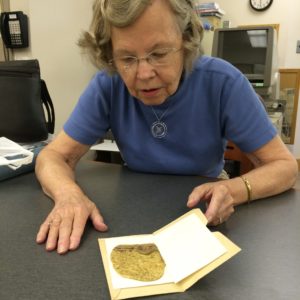by Ruth W. Duncan FALL 2016
 My maternal grandfather was Isaac Ferris (1875-1959) of Riverside, Connecticut, the last owner of the old Ferris house on Boston Post Road (torn down in 1955 to make way for the Thru-Way Shopping Center). In 1996 I went through the papers and things from his desk, which I had inherited from my mother. I found a yellowed clipping from the New York Journal, dated Sunday, September 6, 1896. It told the story of Joseph D. Ferris (1807-1858), my grandfather’s grandfather, who couldn’t sail to New York to attend the hanging of the pirate Charles Gibbs on April 22, 1831, but at whose request a physician-friend brought him a memento—Gibbs’s pericardium, the sack in which the human heart is encased. The story went on to explain how Ferris had it tanned and made into a tobacco pouch. And there it was, among my grandfather’s papers, in a yellowed, letter-sized envelope, flat and dry. Could this be true?
My maternal grandfather was Isaac Ferris (1875-1959) of Riverside, Connecticut, the last owner of the old Ferris house on Boston Post Road (torn down in 1955 to make way for the Thru-Way Shopping Center). In 1996 I went through the papers and things from his desk, which I had inherited from my mother. I found a yellowed clipping from the New York Journal, dated Sunday, September 6, 1896. It told the story of Joseph D. Ferris (1807-1858), my grandfather’s grandfather, who couldn’t sail to New York to attend the hanging of the pirate Charles Gibbs on April 22, 1831, but at whose request a physician-friend brought him a memento—Gibbs’s pericardium, the sack in which the human heart is encased. The story went on to explain how Ferris had it tanned and made into a tobacco pouch. And there it was, among my grandfather’s papers, in a yellowed, letter-sized envelope, flat and dry. Could this be true?
I showed the clipping and tobacco pouch to Susan Richardson, then archivist at the Greenwich Historical Society. She asked to take it to the Connecticut Chief State Medical Examiner’s office for authentication. The examiner, H. Wayne Carver II, was intrigued. After testing a tiny piece, he reported that it was “probably human” in origin.
As it happens, the story of this pirate is well told in Joseph Gibbs’s Dead Men Tell No Tales: The Lives and Legends of the Pirate Charles Gibbs (University of South Carolina Press, 2007). Charles Gibbs was the likely alias of James D. Jeffers, born in Newport, Rhode Island in 1798. Jeffers was a sailor who fell into piracy. On November 24, 1830, Jeffers and his gang mutinied to take possession of the cargo of Mexican silver on the brig Vineyard. Six days later, he and three survivors were captured on Long Island and conveyed to New York City. Only two were charged and tried. In addition to mutiny, Thomas Wansley (1807-1831) was tried for the murder of the ship’s captain. Jeffers was tried for mutiny, the murder of the ship’s mate, stealing cargo, and destroying a vessel. The men were sentenced to hang together April 22, 1831.
Jeffers’s trial and the interviews he gave afterward received heavy and sensational press coverage, ensuring that crowds attended the double hanging on Ellis Island. In those interviews Jeffers told tales of his other deeds (some inconsistent, contradictory and/or impossible to prove). After death, as had been ordered by the judge, the bodies were turned over to John Augustine Smith of the College of Physicians and Surgeons of the University of the State of New York for study, a common practice at the time. Jeffers’s cranium remains in the collection of New York City’s General Society of Mechanics and Tradesmen.
But what about the pericardium? Too much information is missing to prove without a doubt that Joseph Ferris’s tobacco pouch is made from Jeffers’s pericardium. For one, we don’t know who Ferris’s physician-friend was, and so can’t link him to the execution, Smith, or the medical college. Frustratingly, the tanning process likely destroyed the tobacco pouch’s DNA. But in my estimation, it’s not impossible. It seems likely, though, to remain one of history’s intriguing—and slightly gruesome—mysteries. If this tale is true, Jeffers’s head and his heart remain as a cautionary tale against taking up the life of a pirate.
Ruth W. Duncan lives in Fairfax, Virginia.
LISTEN!
Listen to Ruth tell more of this story on our podcast Grating the Nutmeg, episode 17

